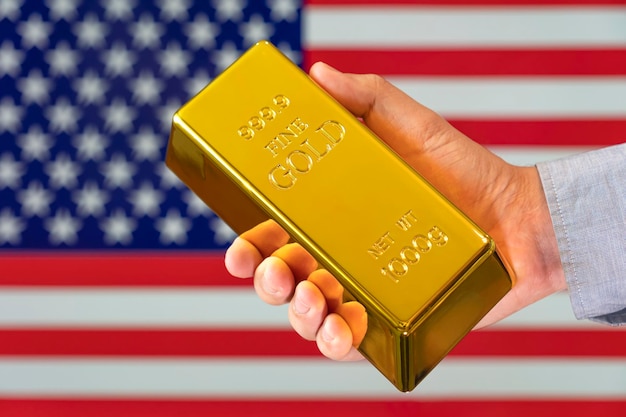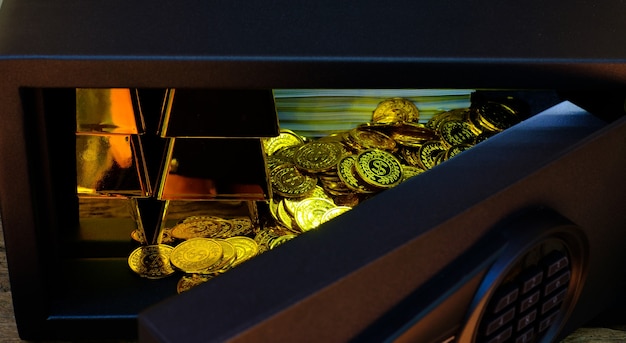Investing in Gold and Silver: A US Investor’s Guide to Hedging

Investing in gold and silver can act as a strategic hedge against inflation and economic uncertainty, offering US investors a tangible asset with potential for long-term value preservation and portfolio diversification.
In times of economic volatility, safeguarding your investments becomes paramount. Investing in gold and silver has historically been a popular strategy to hedge against inflation and navigate periods of uncertainty. This guide offers a comprehensive overview for US investors looking to understand the potential benefits and risks associated with these precious metals.
Understanding Gold and Silver as Investments
Gold and silver have been valued for centuries, not only for their aesthetic appeal but also for their perceived store of value. Understanding their role in investment portfolios requires delving into their characteristics and how they react to market conditions.
These precious metals often move independently of stocks and bonds, making them valuable portfolio diversifiers. Their limited supply and historical role as currency also contribute to their appeal as safe-haven assets.
Historical Performance During Economic Crises
Throughout history, gold and silver have demonstrated their ability to retain value during economic downturns. Analyzing past crises provides insights into their potential performance in similar situations.
Investors often flock to these metals during periods of inflation or market crashes, driving up their prices and potentially offsetting losses in other asset classes.
- 1970s Inflation: Gold prices soared as inflation eroded the value of paper currencies.
- 2008 Financial Crisis: Investors sought refuge in gold and silver as stock markets plummeted.
- Recent Geopolitical Uncertainty: Global events often trigger a flight to safety, boosting demand for precious metals.
By understanding their historical performance, investors can make informed decisions about incorporating gold and silver into their portfolios.

In conclusion, gold and silver have a long history of serving as safe-haven assets, particularly during times of economic turmoil. Their ability to potentially retain value and diversify portfolios makes them attractive options for investors seeking to mitigate risk.
Why Invest in Gold and Silver During Inflation?
Inflation erodes the purchasing power of traditional currencies, prompting investors to seek assets that can maintain their value. Gold and silver offer a potential solution, acting as a hedge against rising prices.
Unlike fiat currencies, whose supply can be increased by central banks, gold and silver have a limited supply, making them resistant to inflationary pressures.
The Relationship Between Inflation and Precious Metals
The relationship between inflation and precious metals is complex but generally positive. As inflation rises, the demand for gold and silver tends to increase, driving up their prices.
This occurs because investors perceive these metals as a store of value that is less susceptible to the erosion caused by inflation.
- Real Interest Rates: Low or negative real interest rates (interest rates adjusted for inflation) can make gold and silver more attractive.
- Currency Debasement: Concerns about currency devaluation can also boost demand for precious metals.
- Supply and Demand Dynamics: Increased demand coupled with limited supply contributes to price appreciation.
Understanding these factors helps investors assess the potential benefits of investing in gold and silver as an inflation hedge.
Therefore, investing in gold and silver during inflation can be a strategic move to preserve wealth. Their historical performance and inherent characteristics make them a valuable tool for navigating inflationary environments.
Different Ways to Invest in Gold and Silver
There are several avenues for US investors to gain exposure to gold and silver, each with its own set of advantages and disadvantages. Choosing the right method depends on individual investment goals and risk tolerance.
From physical bullion to exchange-traded funds (ETFs), the options are diverse and cater to different investment preferences.
Physical Bullion: Coins and Bars
Investing in physical gold and silver involves purchasing coins or bars directly. This method offers tangible ownership but also comes with storage and security considerations.
Popular options include American Eagle coins, Canadian Maple Leaf coins, and various sizes of gold and silver bars.

Gold and Silver ETFs and Mutual Funds
ETFs and mutual funds provide a convenient way to invest in gold and silver without the hassle of storing physical metal. These funds typically track the price of gold or silver or invest in mining companies.
Examples include the SPDR Gold Trust (GLD) and the iShares Silver Trust (SLV).
Mining Stocks: Investing in Gold and Silver Companies
Investing in mining stocks involves purchasing shares of companies that explore, develop, and mine gold and silver. This approach offers potential for higher returns but also comes with increased risk.
Factors to consider include the company’s management, mining operations, and geopolitical risks.
- Direct Ownership: Provides a tangible asset that you can hold and store.
- Liquidity: ETFs and mutual funds offer high liquidity and ease of trading.
- Potential Upside: Mining stocks can provide leverage to the price of gold and silver.
In conclusion, the best way to invest in gold and silver depends on individual circumstances and investment goals. Each method offers unique benefits and risks that investors should carefully consider.
Assessing the Risks and Rewards
Like any investment, gold and silver come with their own set of risks and rewards. Understanding these factors is crucial for making informed investment decisions.
While these metals can offer protection against inflation and economic uncertainty, they are also subject to price volatility and market fluctuations.
Market Volatility and Price Fluctuations
The prices of gold and silver can be volatile, influenced by factors such as economic news, geopolitical events, and investor sentiment. Understanding these drivers is essential for managing risk.
Investors should be prepared for potential price swings and consider diversifying their portfolios to mitigate losses.
Storage and Security Considerations
Storing physical gold and silver requires secure facilities to protect against theft or damage. This can involve additional costs such as storage fees or insurance premiums.
Investors should also consider the liquidity of their investment and the ease of converting physical metal back into cash.
Geopolitical and Economic Factors Influencing Prices
Geopolitical events, such as wars or political instability, can significantly impact the prices of gold and silver. Economic factors, such as interest rates and inflation expectations, also play a role.
Staying informed about these factors can help investors anticipate market movements and make strategic investment decisions.
Overall, assessing the risks and rewards associated with gold and silver is essential for successful investing. By understanding these factors, investors can make informed decisions that align with their financial goals and risk tolerance.
Incorporating Gold and Silver into Your Investment Portfolio
Adding gold and silver to your investment portfolio can provide diversification and potential protection against economic uncertainty. Determining the appropriate allocation depends on individual circumstances and investment objectives.
A common approach is to allocate a small percentage of the portfolio to gold and silver, typically between 5% and 10%.
Diversification Benefits of Precious Metals
Gold and silver often have a low or negative correlation with traditional asset classes, such as stocks and bonds. This means that their prices tend to move independently, providing diversification benefits.
Adding precious metals to your portfolio can help reduce overall risk and improve long-term returns.
Determining the Right Allocation for Your Portfolio
The appropriate allocation to gold and silver depends on your risk tolerance, investment goals, and time horizon. Younger investors with a longer time horizon may be able to tolerate a higher allocation to precious metals.
Older investors seeking income may prefer a lower allocation to reduce volatility.
- Risk Tolerance: Assess your comfort level with price fluctuations.
- Investment Goals: Determine whether you are seeking capital appreciation or income.
- Time Horizon: Consider how long you plan to hold the investment.
In conclusion, incorporating gold and silver into your investment portfolio can be a strategic move to enhance diversification and manage risk. By carefully considering your individual circumstances, you can determine the appropriate allocation to these precious metals.
Tips for Buying and Selling Gold and Silver
Buying and selling gold and silver require careful planning and execution. Following these tips can help investors make informed decisions and avoid common pitfalls.
Whether you are purchasing physical bullion or trading ETFs, these guidelines can improve your chances of success.
Researching Dealers and Verifying Authenticity
When buying physical gold and silver, it is essential to research dealers and verify the authenticity of the metal. Reputable dealers will provide certificates of authenticity and offer secure storage options.
Be wary of dealers offering prices that are significantly below market value, as this could be a sign of counterfeit products.
Understanding Premiums and Spot Prices
The price of gold and silver is typically quoted as the spot price, which is the current market price for immediate delivery. However, investors often pay a premium above the spot price when purchasing physical metal.
Understanding premiums is essential for comparing prices and making informed purchasing decisions.
Timing Your Purchases and Sales
Timing the market is difficult, but investors can use technical analysis and fundamental analysis to identify potential buying and selling opportunities. Look for periods of undervaluation or overvaluation.
Consider using dollar-cost averaging to smooth out price fluctuations and reduce the risk of buying at the wrong time.
In conclusion, following these tips can help investors navigate the complexities of buying and selling gold and silver. By researching dealers, understanding premiums, and timing purchases carefully, you can increase your chances of success.
| Key Point | Brief Description |
|---|---|
| 💰 Inflation Hedge | Gold and silver can protect against the loss of purchasing power during inflationary periods. |
| 📈 Portfolio Diversification | Precious metals offer diversification benefits due to their low correlation with other assets. |
| ⛏️ Investment Methods | Options include physical bullion, ETFs, mutual funds, and mining stocks. |
| ⚠️ Risk Management | Consider market volatility, storage costs, and geopolitical factors. |
Frequently Asked Questions
▼
Gold and silver are seen as safe havens because they tend to maintain or increase their value during economic uncertainty, offering a refuge for investors seeking stability.
▼
Secure storage options include home safes, bank safety deposit boxes, and private vaults specialized in storing precious metals, each with varying levels of security and accessibility.
▼
Tax implications vary based on the investment method and holding period, but generally, profits from selling gold and silver are subject to capital gains taxes, similar to other investments.
▼
Gold and silver ETFs offer liquidity and ease of trading, making them a convenient alternative to physical bullion, especially for investors who prefer not to handle or store physical metals.
▼
Before investing in mining stocks, consider the company’s management, mining operations, geopolitical risks, and the overall market conditions for gold and silver, as these factors can significantly impact stock performance.
Conclusion
Investing in gold and silver can be a prudent strategy for US investors looking to hedge against inflation and economic uncertainty. By understanding the various investment methods, assessing the risks and rewards, and incorporating these precious metals strategically into your portfolio, you can enhance diversification and potentially protect your wealth during turbulent times.





